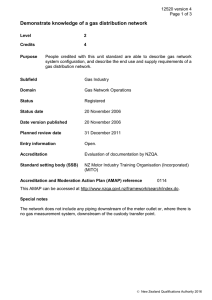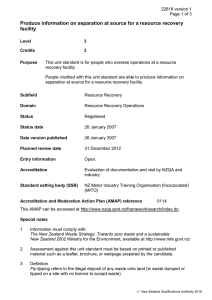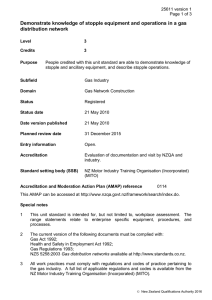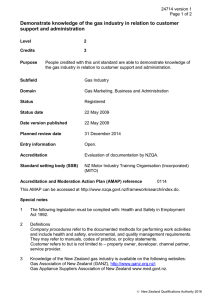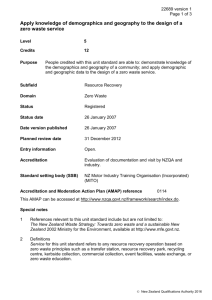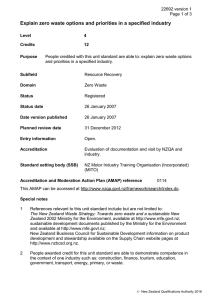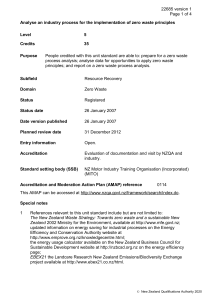Explain pre design issues and discuss the design of a... recovery facility and its components
advertisement
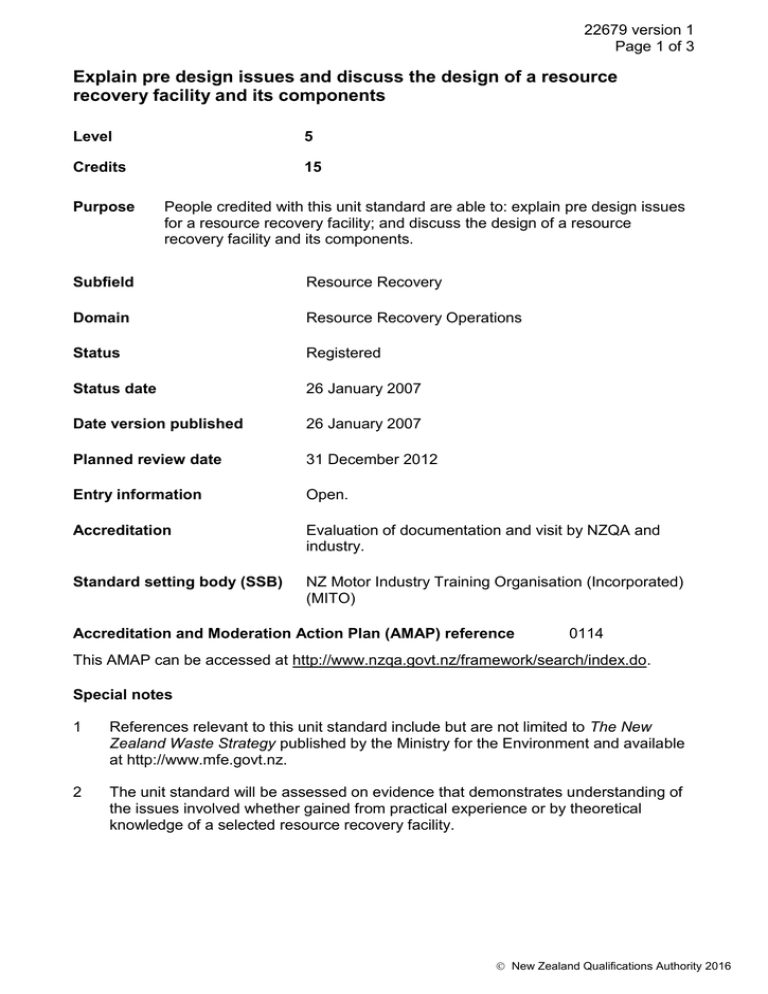
22679 version 1 Page 1 of 3 Explain pre design issues and discuss the design of a resource recovery facility and its components Level 5 Credits 15 Purpose People credited with this unit standard are able to: explain pre design issues for a resource recovery facility; and discuss the design of a resource recovery facility and its components. Subfield Resource Recovery Domain Resource Recovery Operations Status Registered Status date 26 January 2007 Date version published 26 January 2007 Planned review date 31 December 2012 Entry information Open. Accreditation Evaluation of documentation and visit by NZQA and industry. Standard setting body (SSB) NZ Motor Industry Training Organisation (Incorporated) (MITO) Accreditation and Moderation Action Plan (AMAP) reference 0114 This AMAP can be accessed at http://www.nzqa.govt.nz/framework/search/index.do. Special notes 1 References relevant to this unit standard include but are not limited to The New Zealand Waste Strategy published by the Ministry for the Environment and available at http://www.mfe.govt.nz. 2 The unit standard will be assessed on evidence that demonstrates understanding of the issues involved whether gained from practical experience or by theoretical knowledge of a selected resource recovery facility. New Zealand Qualifications Authority 2016 22679 version 1 Page 2 of 3 Elements and performance criteria Element 1 Explain pre design issues for a resource recovery facility. Performance criteria 1.1 The explanation identifies issues arising at facility proposal, design, management, operation, maintenance, and growth stages. 1.2 The explanation identifies environmental issues and describes their implications for the facility. Range 1.3 implications include but are not limited to – compliance with legislation, emergency response plan, community impact. The explanation identifies and describes economic issues for viability of the facility and clarifies key issues relating to the supply of recovered resources. Range viability – short term, long term; supply – consistency, volume, future development. 1.4 The explanation identifies and describes design issues and provides solutions that maximise sustainability, efficiency, economy, and health and safety. 1.5 The explanation identifies and describes operational issues and provides solutions that follow the principle of zero waste. Range operational issues include but are not limited to – resource collection, sorting, storage, processing, staff training, educating the users. Element 2 Discuss the design of a resource recovery facility and its components. Performance criteria 2.1 The discussion assesses the design of the facility in relation to the principle of closing the loop. 2.2 The discussion of access and egress clarifies design requirements and determines solutions that meet the current and future needs of the operator and the users of the facility. Range requirements include but are not limited to – opening times, traffic flow, delivery space, delivery time, restrictions, security; security may include but is not limited to – weighbridge, gate station, designated areas. New Zealand Qualifications Authority 2016 22679 version 1 Page 3 of 3 2.3 The discussion of process and equipment selection assesses the design for current efficiency, and long term sustainability. Range 2.4 process – collection, delivery, sorting, storage, treatment, disposal. The discussion of storage design selects types appropriate for the resources to be received and/or recovered. Range resources include but are not limited to three of – hazardous, liquid, solid, bulky, fragile, organic. 2.5 The content of signage is discussed in terms of advising and educating the public and/or clients to meet facility acceptance requirements. 2.6 Design of signage and labels is discussed in accordance with legislation, and in relation to clarity, consistency, and colour. 2.7 The discussion assesses the design for coverage of factors essential to the development and operation of the facility. Range includes – objectives, resources that are available to meet objectives, time frame, responsibilities and training of people who will be involved in the facility, contingencies, methods for evaluating the achievement of the objectives. Please note Providers must be accredited by the Qualifications Authority, or an inter-institutional body with delegated authority for quality assurance, before they can report credits from assessment against unit standards or deliver courses of study leading to that assessment. Industry Training Organisations must be accredited by the Qualifications Authority before they can register credits from assessment against unit standards. Accredited providers and Industry Training Organisations assessing against unit standards must engage with the moderation system that applies to those standards. Accreditation requirements and an outline of the moderation system that applies to this standard are outlined in the Accreditation and Moderation Action Plan (AMAP). The AMAP also includes useful information about special requirements for organisations wishing to develop education and training programmes, such as minimum qualifications for tutors and assessors, and special resource requirements. Comments on this unit standard Please contact the NZ Motor Industry Training Organisation (Incorporated) (MITO) info@mito.org.nz if you wish to suggest changes to the content of this unit standard. New Zealand Qualifications Authority 2016

